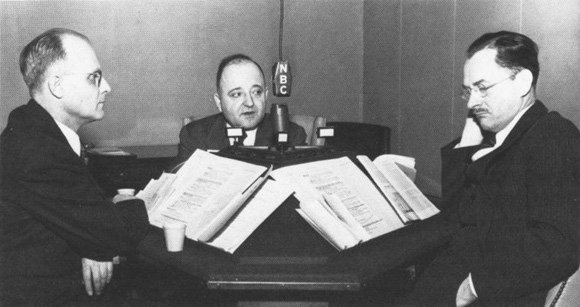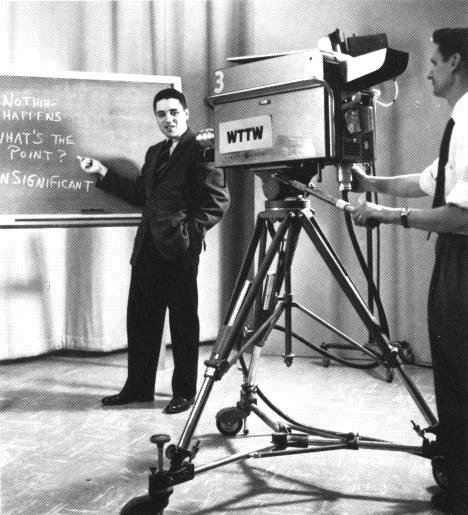The University on the Air
That first experiment led
to the long-running "University of Chicago Round Table" radio program.
In the mid-1930s, WMAQ's parent network, NBC, picked up the program
for broadcast nationally on Sunday afternoons. Much of the program's
success was due to William Benton, co-founder of the Benton and Bowles
advertising agency, a trustee and vice-president of the University,
who saw early the power mass media could have in presenting the University
to the public.
Benton encouraged President Hutchins to improve the quality of the "Round Table" and expand its reach. By 1951, the "Round Table" was carried by ninety-eight network and twenty educational radio stations and had the largest national audience of any discussion program. Over the years, participants included public figures such as John F. Kennedy, Ralph Bunche, Jawaharlal Nehru, and Adlai Stevenson as well as a wide range of University faculty from all disciplines.
Although the radio version of the "Round Table" was discontinued in 1955, it was reincarnated as a television program from 1967 to 1974. Chicago's educational television station, WTTW, produced the new "Round Table" initially for the local audience and then later for distribution to public television stations throughout the Midwest.
The University has made other forays into broadcast media, most of them created for Chicago audiences. After WTTW first came on the air in 1955, the University produced "The Humanities," a thirteen-week, noncredit course broadcast from the station's studios, which were then located in the Museum of Science and Industry. In the 1960s, "University Radio News," broadcast over station WFMT, provided a look at recent developments in University research. Two weekly radio programs, "From the Midway" and "Conversations at Chicago," produced in the 1960s and 1970s, picked up the discussion format pioneered by the "Round Table." As in earlier decades, the University continued to maintain a media presence that helped shape public understanding of its academic programs and the work of its faculty.
With support from the William Benton Foundation, a new venture began in 1983 when radio and television journalists came to campus as Benton Fellows, taking regular University courses in areas of personal interest and participating in special seminars on public policy issues. The six-month program allowed journalists to reflect on issues facing their profession in ways not usually possible under deadline pressure. In 1987 the Benton Broadcast Project initiated plans to develop broadcast treatments for scholarly activities and research projects. One of its first products was "Bastille," an ambitious radio dramatization marking the bicentennial of the French Revolution.

Left to right: T. R. McConnell, Louis Wirth, and Earl J. McGrath. T. R. McConnell was a member of President Truman's Commission on Higher Education, which predicted a doubling of college students by 1960. Louis Wirth, a frequent Round Table panelist, called the finding "fantastic."

